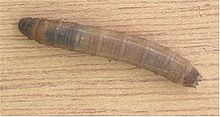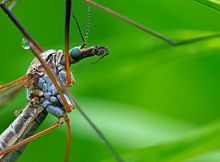- Crane fly
-
Crane fly 
Nephrotoma (spotted crane-fly) 
larva (leatherjacket) Scientific classification Kingdom: Animalia Phylum: Arthropoda Class: Insecta Order: Diptera Suborder: Nematocera Infraorder: Tipulomorpha Superfamily: Tipuloidea Family: Tipulidae
Latreille, 1802Genera see text
A crane fly is an insect in the family Tipulidae. Adults are very slender, long-legged flies that may vary in length from 2–60 millimetres (0.079–2.4 in) though tropical species may exceed to 100 millimetres or 3.9 inches.
In the United Kingdom, Ireland, Newfoundland and Nova Scotia they are commonly referred to as daddy long-legs, but this name can also refer to two unrelated arthropods: members of the arachnid order Opiliones (especially in the United States and Canada) and the cellar spider Pholcidae (especially in Australia). The larva of the European Crane Fly is commonly known as a leatherjacket. These larvae can cause damage to lawns by feeding on the roots of grass plants.
Numerous other common names have been applied to the crane fly, many of them more or less regional, including mosquito hawk, mosquito wolf, mosquito eater (or skeeter eater), soldier , gallon-nipper,[1] and gollywhopper.[1]
At least 4,256 species of crane flies have been described, most of them (75%) by the specialist Charles Paul Alexander. This makes Tipulidae one of the largest families of Diptera (although smaller than Limoniidae, one of the other extant families of crane flies).
Contents
Morphology
In appearance crane flies seem long and gangly, with very long legs, and a long slender abdomen. The wings are often held out when at rest, making the large halteres easily visible. Unlike most flies, crane flies are weak and poor fliers with a tendency to "wobble" in unpredictable patterns during flight, and they can be caught without much effort.
Crane flies vary in size, with temperate species ranging from 2 to 60 millimetres (0.079 to 2.4 in), while tropical species have been recorded at over 100 millimetres (3.9 in). The giant crane fly (Holorusia rubiginosa) of the western United States can reach 38 millimetres (1.5 in). Some Tipula species are 64 millimetres (2.5 in). Many smaller species (known as bobbing gnats) are mosquito-sized, but they can be distinguished from mosquitoes by the V-shaped suture on the thorax, nonpiercing mouthparts, and a lack of scales on the wing veins.
Female abdomens contain eggs, and as a result appear swollen in comparison to those of males. The female abdomen also ends in a pointed ovipositor that may look somewhat like a stinger, but is in fact completely harmless.
Adult mouthparts may occur on the end of the crane fly's long face, which is sometimes called a snout or a short rostrum.
Larvae have a distinct head capsule, and their abdominal segments often have long fleshy projections surrounding the posterior spiracles (almost like tentacles).
Ecology
Despite their common names, as adults, crane flies do not prey on mosquitoes, nor do they bite humans. Some larval crane flies are predatory and may eat mosquito larvae.[2] Adult crane flies feed on nectar or they do not feed at all. Once they become adults, most crane fly species exist as adults only to mate and die. Their larvae, called "leatherjackets", "leatherbacks", "leatherback bugs" or "leatherjacket slugs", because of the way they move, consume roots (such as those of turf grass) and other vegetation, in some cases causing damage to plants. The crane fly is occasionally considered a mild turf pest in some areas. In 1935, Lord's Cricket Ground in London was among the venues affected by leatherjackets: several thousand were collected by ground staff and burned, because they caused bald patches on the wicket and the pitch took unaccustomed spin for much of the season.[3]
Little is known of the juvenile biology of many crane fly species. The larvae of less than 2% of the species have been described. Of those that have been described, many prefer moist environments, and some leatherjackets are aquatic.
Genera
- Subfamily Ctenophorinae
-
- Ctenophora Meigen, 1803
- Dictenidia Brulle, 1833
- Phoroctenia Coquillett, 1910
- Pselliophora Osten Sacken, 1887
- Tanyptera Latreille, 1804
- Subfamily Dolichopezinae
-
- Dolichopeza Curtis, 1825
- Subfamily Tipulinae
-
- Acracantha Skuse, 1890
- Angarotipula Savchenko, 1961
- Austrotipula Alexander, 1920
- Brachypremna Osten Sacken, 1887
- Brithura Edwards, 1916
- Clytocosmus Skuse, 1890
- Elnoretta Alexander, 1929
- Euvaldiviana Alexander, 1981
- Goniotipula Alexander, 1921
- Holorusia Loew, 1863
- Hovapeza Alexander, 1951
- Hovatipula Alexander, 1955
- Idiotipula Alexander, 1921
- Indotipula Edwards, 1931
- Ischnotoma Skuse, 1890
- Keiseromyia Alexander, 1963
- Leptotarsus Guerin-Meneville, 1831
- Macgregoromyia Alexander, 1929
- Megistocera Wiedemann, 1828
- Nephrotoma Meigen, 1803
- Nigrotipula Hudson & Vane-Wright, 1969
- Ozodicera Macquart, 1834
- Platyphasia Skuse, 1890
- Prionocera Loew, 1844
- Prionota van der Wulp, 1885
- Ptilogyna Westwood, 1835
- Scamboneura Osten Sacken, 1882
- Sphaerionotus de Meijere, 1919
- Tipula Linnaeus, 1758, 1758
- Tipulodina Enderlein, 1912
- Valdiviana Alexander, 1929
- Zelandotipula Alexander, 1922
See also
- Tipularia discolor, the crane fly orchid
References
- ^ a b Dictionary of American Regional English. http://books.google.com/books?id=vAr2T4Bh7nkC&pg=PA620&lpg=PA620&dq=gollywhopper+-wikipedia+%22crane+fly%22&source=bl&ots=yO7kfvT_wr&sig=br834TNyyx2l1eBkRPiypAZxpxg&hl=en&ei=OiGmSZG6OJqqtQPMrqT3Dw&sa=X&oi=book_result&resnum=3&ct=result#PPA620,M1.
- ^ Crane Flies of Kentucky - University of Kentucky Entomology
- ^ Andrew Ward. Cricket's Strangest Matches (1998 ed.). Robson Books, London. p. 111.
External links
- Delta-Intkey.com, Family descriptions and images
- Ohioline.osu.edu, Ohio State University Fact Sheet
- Mosquito Hawk Information
- IZ.carnegiemnh.org, Crane Flies of Pennsylvania, Extensive Specimen Collection, Carnegie Museum of Natural History
- NLBIF.eti.uva.nl, Catalog of Craneflies of the World
- Diptera.info, Image Gallery
- BugGuide.bet, photo gallery, many species
- Gaga.jes.mlc.edu.tw, Tipulidae of Taiwan (Chinese), with images under Latin binomials
- Insects.tamu.edu, Texas A&M Entomology Field Guide
- Rowland Lawn Direct, More information on Leatherjackets
Species lists
- Faunaeur.org, Palaearctic
- Nearctica.com, Nearctic
- Konchudb.agr.agr.kyushu-u.ac.jp, Japan
- Oosterbroek, Pjotr, HBS.Bishopmuseum.org, "Tipulidae"
Categories:- Insect families
- Tipulidae
Wikimedia Foundation. 2010.


